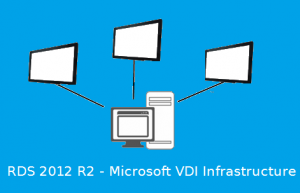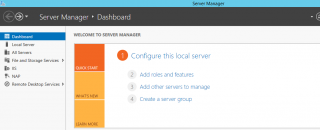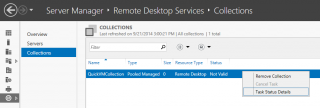
Hello World,
I was hesitating about which topic to touch regarding Remote Desktop Services. We have already posted a lot of information about Remote Desktop Services and RemoteApp technology. However, we still need to cover some important topics such as high availability. On the other hand, Remote Desktop Services also provide VDI solutions for Enterprises which is a topic I’m finding more and more in my projects.
VDI is another aspect of the Remote Desktop Services and I think it’s important to show this aspect before talking about High availability. High availability and custom configurations can be touched after we have a global overview of the Remote Desktop Technology.
For people interested in an introduction of RDS and detailed information about RemoteApp, please review our previous posts on the subject
- RDS – Remote Desktop Services Overview – PART I
- RDS – Remote Desktop Services Roles – Part II
- RDS – Quick Install Remote Desktop Service – Part III
- RDS – New RDMS Management Console – Part IV
- RDS – Accessing your RemoteApp – Part V
- RDS – More configuration for RemoteApp Access – Part VI
- RDS – Configuring Windows Integrated Authentication (WIA) – PART VII
- RDS – Publishing RemoteApp – Part VIII
- RDS – Remote Desktop Gateway – Part IX
- RDS – Licensing Server – Part X
In this post, we will describe how you can setup a VDI infrastructure (the easy way)
VDI Overview
VDI Pool vs Personal Virtual Desktops
As mentioned earlier, RDS 2012 R2 provide VDI capability. VDI or Virtual Desktop infrastructure is basically a solution where a user will connect to a virtual machine using remote desktop client and access a full desktop environment. However, you can still make a additional distinction in VDI deployment.
In fact, Microsoft RDS 2012 R2 support two VDI deployment scenarios :
- Virtual Desktop pools and,
- Personal Virtual Desktops
The difference between the two scenarios is based on the way you assign virtual machines to end users. In a Personal Virtual Desktop scenario, a dedicated user will have access to a dedicated Virtual machine. In a VDI pool scenario; the virtual machines is not assigned specifically to one user but will be shared between multiple users.
Something I didn’t know is that there is an additional distinction made by Microsoft when talking about VDI pool. You can have
- VDI managed pool
- VDI umanaged pool
In the VDI Managed pool, we will create the VDI pool based on the VM template. The unmanaged scenario would be where we would simply add into a vdi collection an existing Virtual machine…
Pre-requisites for VDI and RDS 2012 R2
In our simple scenario, we will have only one server that will be used and where we will install the RDS components. Because we will be working with virtual machines, we will need to have
- Hyper-v installed on the target RDS server.
- a Virtual Machine template (which needs to be sysprepped)
- Enough right in your Active Directory in order to delegate control to the OU where your virtual machines will be created.
When you have this, you should be ready to go and proceed with your installation.
Step by Step Installation Procedure
In this post, we will assume that we want to deploy the Remote Desktop Services on asingle Server. We want to demonstrate the installation. All the needed roles will be installed on a single server. In coming posts, we will have a look at a more complex deployment strategy. The single server installation is to get used to the new installation procedure and the new management tool. We also assume that you want to deploy VDI infrastructure and not the Remote Session based infrastructure.
We assume that you are familiar with the new RDMS management interface (if not, refer to the links above)
To perform the installation, you will proceed with the following actions :
Step 1 – Open Server Manager and click on Add Roles and features
Click on Picture for Better Resolution
Step 2 – In the Before you Begin Page, Press Next
Click on Picture for Better Resolution
Step 3 – In the Select Installation page, choose Remote Desktop Services Installation option. Press Next
Click on Picture for Better Resolution
Step 4 – In the Select Deployment type page, select Quick Deployment. Press Next
Click on Picture for Better Resolution
Step 5 – In the Select Deployment Scenario, Select Virtual Machine based desktop deployment. Press Next
Click on Picture for Better Resolution
Step 6 – In the Select a Server Page, Choose your server, add to the right column and press Next
Click on Picture for Better Resolution
Step 7 – Select a Virtual Desktop Template Page, Sepcify location of your virtual desktop template. Press Next
Click on Picture for Better Resolution
Click on Picture for Better Resolution
Step 8 – In the Confirm selection, review your settings. Tick the checkbox next to restart the server and then you should be able to press Deploy
Click on Picture for Better Resolution
Step 9 – In the View Progress Page, you can monitor the progress
Click on Picture for Better Resolution
Step 10 – In the View Progress Page, if you see that installation is completed and succesful, you can press the close button
Click on Picture for Better Resolution
After you have performed the installation, from the Server Manager, you will be able to manage your RDS server using the new RDMS Management interface. If you click in the Server Manager on the Remote Desktop Services > Collections Node. you should see a collection called QuickVMCollection that has been created for you.
Click on Picture for Better Resolution
If you look on my screenshot, you will notice that in the Status column, I have an error message stating that the Collection is Not Valid. To get a hint on the possible issue, you can right-click on the collection and select Task Status Details.
Click on Picture for Better Resolution
If your are lucky, you will see a message explaining why the collection was not created successfully.
Click on Picture for Better Resolution
In my case, the collection was not created because the virtual desktop template was not installed with the latest integration services software.
So, at this stage, we have installed our RDS infrastructure but the VDI pool collection just failed. (Next time, we will use the standard deployment process)
This is the perfect excuse to show you how to create (manually) a vdi pool… but this will be for the next post….I have to go 🙂
Final Notes
We have just shown how to perform the installation of the RDS infrastructure to host VDI pool on a single server. In our experiment, the vdi pool was not created because of invalid integration services. This offer us a chance to demonstrate how to create the VDI pool through the RMDS Wizard.
The setup of RDS infrastructure is really not difficult. We have encountered main issues in the VDI pool creation. Some issues were easy to fix some were hard to diagnose but all in all we suceeded all the time
Till next time
See ya


Thank you for this great job.
liitle question
Is there still an interest to have SCVMM server 2012R2??
Hello Ben,
SCVMM is the MS management tool for Hyper-V and virtual infrastructure. If you are creative enough and you do not have specific needs, you can go away from SCVMM. Replace SCVMM options using Powershell scripts or free MS Tools (such as MDT for deploying Hyper-v or VM templates), clear procedure to be followed
SCVMM is offering a lot of options but it also a little bit more complex to configure initially. If you have a real use for it, SCVMM is still interesting to be used. The tool is more often used by big hosting providers and IAAS or PAAS providers than “normal” companies.
I will be working soon with SCVMM in a project where we need to provide a IAAS/PAAS infrastructure where we will delegate rights to the users to create their own virtual machines. If I have time, I will post some info in this blog
Hope this help
Till next time